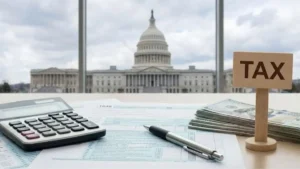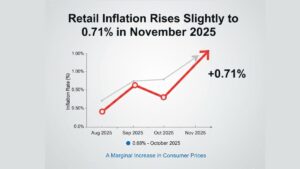India Ratings and Research (Ind-Ra) has revised its GDP growth estimate for the current fiscal year upward to 6.7% from the earlier 6.2%, citing a resilient economy, sustained government capital expenditure, and the potential for a new private corporate capital expenditure cycle. The agency acknowledges risks such as weak global growth, trade uncertainties, and volatile geopolitical situations that may limit India’s GDP growth.
Key Points
-
Positive Drivers: The upgrade is attributed to the resilience of the Indian economy, sustained government capex, a deleveraged corporate/banking sector balance sheet, and the potential for a new private corporate capex cycle. Business and software services exports, along with remittances from abroad, contribute to enduring momentum.
- Consumption Challenges: Ind-Ra notes that consumption demand lacks widespread distribution, emphasizing the importance of wage growth for overall consumption. Real wage growth for lower-income households is crucial for a sustainable recovery, as current consumption demand is biased towards higher-income households.
- Wage-Growth Impact: Ind-Ra’s computations suggest that a 1% increase in real wages could potentially lead to a 1.12% growth in real private final consumption expenditure (PFCE), contributing to a 64 basis point increase in GDP growth.
- RBI’s Projections: The Reserve Bank of India anticipates a sequential slowdown in GDP growth in the last two quarters of FY24, projecting an overall GDP of 7%.
-
Inflation Outlook: Ind-Ra expects average retail and wholesale inflation to be 5.3% and 0.6%, respectively, in FY24.
Important Questions Related to Exams
-
What factors contributed to Ind-Ra’s upward revision of India’s GDP growth forecast for FY’24?
- How does Ind-Ra emphasize the importance of wage growth in achieving sustainable consumption demand?
- What are the key challenges and risks highlighted by Ind-Ra that could potentially limit India’s GDP growth in the current fiscal year?
-
According to Ind-Ra, what is the expected impact of a 1% increase in real wages on the growth of real private final consumption expenditure (PFCE) and overall GDP growth?
Please provide your answers in the comment section!!




 India’s Forex Reserves Rise by $1.68 Bil...
India’s Forex Reserves Rise by $1.68 Bil...
 India’s Net Direct Tax Collections Rise ...
India’s Net Direct Tax Collections Rise ...
 Retail Inflation Rises Slightly to 0.71%...
Retail Inflation Rises Slightly to 0.71%...







